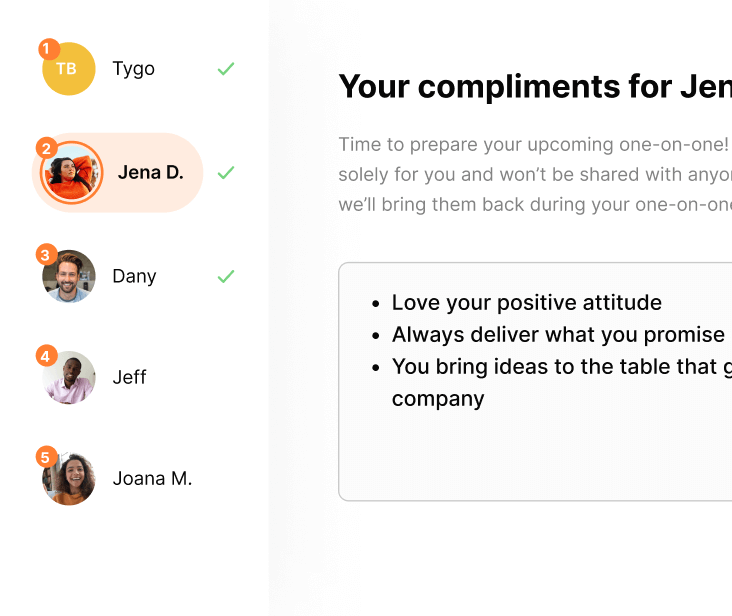Back to Blog
2023 employee turnover: statistics, trends & reasons
“2022 was the real year of the Great Resignation,” said economist Julia Pollak to CNBC. Indeed, in 2022, we heard a lot of newly-coined terms such as quiet quitting, read about layoffs in various companies, and saw more quits than ever.
Why do people leave their jobs? As employee retention becomes a priority for companies in 2023, answering this question is crucial. Here are some recent statistics on employee turnover to guide us.
What is employee turnover, and why is it important?
Employee turnover is the total number of workers who leave their jobs over a given period. There are two types of employee turnover:
Voluntary turnover: employees leave their companies by their own choice.
Involuntary turnover: the company lays employees off.
Calculating the cost of employee turnover can give you an insight into its impact on your business performance. In general, a high employee turnover causes;
- reduced productivity
- increased recruitment and training costs
- decreased employee engagement
Key employee turnover statistics
1. In December 2022, the number of job openings in the US increased to over 11.0 million. The hire rate (4.0%) and the average employee turnover rate (3.8%) did not change much compared to last year.
2. The voluntary turnover rate dropped from 36% to 25% in one year.
3. Reports from Payscale, LinkedIn, and Glassdor & Indeed found that compensation was the main reason behind employee turnover.
4. The future of work is flexible. When asked the main reasons why they are considering switching jobs, 28% of employees mentioned work flexibility.
5. On the HR side, priorities are changing. In 2022 and onwards, hiring is no longer a top priority. Instead, companies will focus on employee retention.
6. 39% of HR leaders say that offering competitive salaries is their biggest recruitment challenge.
7. 93% of organizations are concerned about employee retention and, thus, turnover.
8. The cost of employee turnover is estimated to be approximately 33% of employees’ base pay.
9. Despite all the layoffs and quits, 95% of people feel confident about their career prospects in 2023.
Share fun facts and bond with a team quiz
Have your participants choose from a list of questions they’d like their coworkers to answer about them, before watching as they guess the right answer.
01. Yes
share-fun-facts-and-bond-with-a-team-quiz

Run a guided recognition activity
Have your participants choose from a list of questions they’d like their coworkers to answer about them, before watching as they guess the right answer.
01. Yes
run-a-guided-recognition-activity

Organize a virtual cooking class
Hire a professional chef to help your team cook a delicious lunch or dinner. May be difficult for co-workers with families. To find providers and get tips, read our blog about virtual cooking classes.
02. No
organize-a-virtual-cooking-class

Hire a stand-up comedian
Have your participants choose from a list of questions they’d like their coworkers to answer about them, before watching as they guess the right answer.
02. No
hire-a-stand-up-comedian

No items found
No items found
Table of contents
“2022 was the real year of the Great Resignation,” said economist Julia Pollak to CNBC. Indeed, in 2022, we heard a lot of newly-coined terms such as quiet quitting, read about layoffs in various companies, and saw more quits than ever.
Why do people leave their jobs? As employee retention becomes a priority for companies in 2023, answering this question is crucial. Here are some recent statistics on employee turnover to guide us.
What is employee turnover, and why is it important?
Employee turnover is the total number of workers who leave their jobs over a given period. There are two types of employee turnover:
Voluntary turnover: employees leave their companies by their own choice.
Involuntary turnover: the company lays employees off.
Calculating the cost of employee turnover can give you an insight into its impact on your business performance. In general, a high employee turnover causes;
- reduced productivity
- increased recruitment and training costs
- decreased employee engagement
Key employee turnover statistics
1. In December 2022, the number of job openings in the US increased to over 11.0 million. The hire rate (4.0%) and the average employee turnover rate (3.8%) did not change much compared to last year.
2. The voluntary turnover rate dropped from 36% to 25% in one year.
3. Reports from Payscale, LinkedIn, and Glassdor & Indeed found that compensation was the main reason behind employee turnover.
4. The future of work is flexible. When asked the main reasons why they are considering switching jobs, 28% of employees mentioned work flexibility.
5. On the HR side, priorities are changing. In 2022 and onwards, hiring is no longer a top priority. Instead, companies will focus on employee retention.
6. 39% of HR leaders say that offering competitive salaries is their biggest recruitment challenge.
7. 93% of organizations are concerned about employee retention and, thus, turnover.
8. The cost of employee turnover is estimated to be approximately 33% of employees’ base pay.
9. Despite all the layoffs and quits, 95% of people feel confident about their career prospects in 2023.
Employee turnover costs
Employee turnover costs depend on various factors, such as the company’s size and employee seniority. According to the 2022 Retention Report by the Work Institute, the cost for the average US employee is approximately $15,000. Josh Bersin, the founder of Deloitte, shared years ago that it could be as high as 1.5-2 times the employee’s salary.
The top reasons for employee turnover
From low pay to the lack of support at work, there are main reasons why employees quit. The first step in avoiding high employee turnover is to be aware of them. Here is what the latest workplace turnover statistics show:
1. Compensation: there is a lack of competitive pay
The number one reason why employees quit their jobs is the lack of competitive pay, according to reports from Payscale, Glassdoor & Indeed, and LinkedIn Learning. This includes problems with pay equity and a lack of benefits. Although HR leaders find it difficult to offer competitive pay, they can still set themselves apart by providing benefits, such as health insurance, paid time off, retirement plans, and flexible working.
2. Stress and well-being: how we feel at work matters
86% of employees say that how they feel at work affects how they feel at home. Glassdoor & Indeed’s report found that stress is the second factor leading to employee turnover. If this is the case for you, it is time to take action. The first step would be to ask them why they’re stressed. Then, you can use employee engagement platforms to measure what your team needs.
We must also keep in mind that Gen Z and millennials work differently than Gen X and baby boomers. Making 46% of the full-time U.S. workforce, people born between 1980 and 2001 want an organization that cares about employees' well-being. The two previous generations prioritize ethical leadership over well-being.
3. Recognition: employee appreciation must become a priority
79% of employees would prefer a job where they are recognized over a job where they are not valued but paid more. Plus, employees who say they are never recognized at work are 39% more likely to look for other jobs in 2023. Since recognition and employee engagement go hand in hand, using dedicated platforms can help if you’re unsure how to recognize your teammates. For beginners, we recommend Appreciation Shower.
4. Flexibility: employees like choosing when and where they work
Remote work is here to stay. According to Buffer’s State Of Remote Work 2023, 98% of remote workers would recommend remote work to others. Lack of flexibility is one of the driving factors in employee turnover, with 28% of employees changing jobs because of it.
5. Learning opportunities: developing new skills is a way of career advancement
“People who aren’t learning will leave,” says LinkedIn Learning’s 2023 Workplace Learning Report. Especially younger workers are looking to develop their skills and broaden their networks. Whether your team is on-site or remote, you can create learning opportunities through skill-based team building activities and lunch and learns.
6. Career growth: making an internal move makes people stay
After the two-year mark, most employees expect to make an internal move. In fact, employees that have moved internally are 19% more likely to stay. Yet, only 15% of organizations encourage employees to move to a new role.
7. Poor management: voluntary turnover can be prevented
Last but not least, employees leave because of poor management. In a Gallup survey, 52% of employees who quit said that their manager or organization could have done something to prevent them. This could be offering a promotion, making work more flexible, or improving company culture by team building, be it virtually or in person. It all depends on what your team needs.
Average employee turnover rate by industry
Each season, the U.S. Bureau of Labor Statistics updates statistics on the employee turnover rate by industry. In 2022, industries that saw high employee turnover rates were leisure, hospitality, arts, entertainment, and recreation. The government had low turnover rates, just like last year.
Employee turnover rate by country/region
Employee turnover rates depend on the country, as many factors are involved. The one trend that has affected everyone? The Great Resignation. Here are some key stats on certain countries and regions.
- USA: According to the Salary Increase and Turnover Study by Aon, 22.8% of U.S. employees left their jobs in 2022, and 18.4% were voluntary.
- European Union: Eurostat publishes job vacancy rates in each European country. This can give us an idea of the turnover rate. We can see that from Q3 of 2021 to Q4 of 2022, the job vacancy rate rose from 2.6% to 3.1%. You can check country-specific information in the table below:
- UK: According to a survey made in the UK, job resignations reached an all-time high in 2022.
- India: An Aon survey found that the employee turnover in India was 20.3% for the first half of 2022. It is predicted to increase in 2023.
Learn more with these original sources on employee turnover statistics we’ve used in this article:
- Achievers: The future is flexible: 2023 workforce trends The 6th annual Engagement and Retention Report (available to download upon request)
- Aon: Voluntary Employee Departures Spike 37 Percent Among U.S. Businesses
- Aon: Aon Survey Finds Salaries in India Expected to Increase by 10.4 percent in 2023
- Buffer: State of Remote Work 2023
- CNBC: 2022 was the ‘real year of the Great Resignation,’ says economist
- Eurostat: Job vacancy statistics
- Gallup: The Real Value of Getting an Exit Interview Right
- Gallup: 4 Things Gen Z and Millennials Expect From Their Workplace
- Lattice: State of People Strategy 2023
- LinkedIn Survey: Ready for Anything: Jobs Come and Go, But Your Career is Here to Stay
- LinkedIn: 2023 Workplace Learning Report
- McKinsey: Americans are embracing flexible work—and they want more of it
- Payscale: 2023 Compensation Best Practices Report
- Statista: Estimated number of job-to-job resignations in the United Kingdom from 4th quarter 2001 to 4th quarter 2022
- WorkInstitute: 2022 Retention Report: How Employers Caused The Great Resignation
- U.S. Bureau of Labor Statistics: Job Openings and Labor Turnover Survey
Subscribe to get our latest updates
Subscribe to get our latest updates
.png)




.jpg)

.jpg)